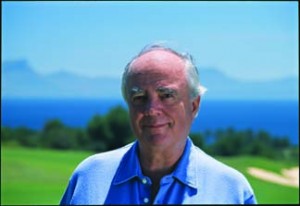
Photo by Taliaferro Jones
Behind many of his more than 250 golf designs in more than 40 countries on six continents, stands a man who works on many levels, who welcomes a new challenge, and who sees the game and his pursuit of it as not just a physical– but as a metaphysical– journey. Like the best writers and artists, Jones employs subtext and symbolism, imagery and illusion, as well as a range of other techniques from the verbal and visual arts to express aspects of philosophy, drama, and aesthetics. And his courses tell stories.
Jones may actually be an even better storyteller than he is a designer. Ask him a question and he’ll string together anecdotes and adventure tales from his travels around the globe, dropping the names of famous golfers, celebrities, and political figures. Yet while he enjoys being the center of attention– whether at a cocktail party hosted by a U.S. Ambassador, or drinking a beer in the clubhouse after a round of golf– Jones is also eager, interested, and absorbed in what other people have to say. He is generous, genuine, and thoroughly likable, if also impatient and strong willed. He also possesses an admirable short game.
I spent a long weekend with Jones at his Royal Westmoreland Golf Course in Barbados. Our interviews took place at crowded lunch tables, over rum punches on the beach, at dinner parties, and out on the golf course. Playing with Jones provides a view of golf course design the depths of which most people would never fathom. Talking with him provides an opportunity to discuss aspects of the game that don’t receive nearly enough attention in conversation or in print.
One lasting impression: after hitting a mediocre approach shot on the dramatic quarry hole at Royal Westmoreland, Jones faced an impossible sidehill putt on a slick, sloping green. After studying it from various angles and frowning his displeasure, he looked up from his ball and said: “I designed it, so I’ll have to play it.”
JCW: Did you learn anything in particular while studying at Yale University that helped in your career?
RTJ Jr.: I learned how to think. During the time I was there, Yale offered a very strict education. I studied geology, which was useful later on. As an American Studies and History major (Liberal Arts), I learned to write and to pursue highly critical thinking. And I learned how to learn– how to go to a source like the library, or an older person, and learn what I needed to know from that source, and apply my own thinking to it.
My education has helped me read golf history with a different eye. I might read about a course in India and wonder what the British were doing there, and why. I learned how to ask a historian’s questions: what motivated them to bring their game there and put it inside a horse paddock? Why were there walls around those places? What was going on? By asking these questions you see how the golf courses themselves were interpreted through the environment they were designed and implemented into.
Golf course design provided a strong connection between you and your father. Did it also provide an opportunity to assert your independence?
RTJ Jr.: My father wasn’t only my father; he was my mentor. At some point in every relationship, a mentor and his student have to separate. They both know that. For me, designing the Navatanee course in Bangkok– where the first World Cup was played– was very liberating. I went all the way to Bangkok in 1969 in order to establish my own credibility. Later, in 1975, when the Vietnam War had just ended, Jack Nicklaus declined to play in the World Cup there because it was supposedly too dangerous.
But nobody had actually thought about it. So I called General Scowcroft, the head of the National Security Council, and asked if it was really too dangerous. I didn’t want to lose this opportunity. And the Council told me that at that time there was no reason not to go. So they played the tournament. Johnny Miller won, the U.S. team won, and I had a good time at the pro-am. Navatanee was my first course used in professional championship play and the tournament was well publicized. That was very helpful in my career.
Your own travels and experiences seem to suggest that the game can serve as a form of adventure– not the first word that comes to mind when most folks think about golf . . .
RTJ Jr.: Any game anywhere is an adventure. But going to distant locations and playing a round of golf in a totally alien context– like in Russia or Shanghai– even though the game is familiar to you, the experience and location will be different from anything you’ve ever experienced before.
Tell us a little more about your own golf-related adventures. What was your wildest experience?
RTJ Jr.: One day in Desaru, Malaysia I walked across a log that had fallen in a putrid swamp, and a snake slithered away. When my guide took out his machete I knew we were in trouble. I asked him, “What’s up?” He said, “It’s a Krait snake.” I said, “What happens if he bites you?” And the guide said, “Smoke one cigarette, and say good-bye.”
Two weeks earlier a wild elephant had pushed over our construction shack during the night. Then we found out that tigers had been coming out of the jungle to lick the salt on the beach near the sea where we were working. On the ride out to the site one day, an elephant was sleeping in the road, and my driver, Chan, stopped the jeep and climbed down and started speaking very calmly and soothingly to the elephant, and it got up and quietly walked off. I asked him what he’d done, and he said he asked, “Lord of the jungle, may we pass?” So I asked how he knew the elephant understands him, and he just said: “He understands me because I respect him.” That was a difficult job. Our supervisors kept quitting.
Another wilderness experience was designing the Wild Coast Golf Course, in Transkei, South Africa. The rough plunges down into ravines, and one hole plays across a natural waterfall. A real one. If you lose your ball you don’t go down there, because that’s where the black mamba, a poisonous snake, lives. Wild monkeys run onto the 6th green and steal your golf ball even today.
How do you express your own adventurous experiences in your golf course designs?
RTJ Jr.: One way is through heroic golf holes– similar to the great eighth at Pebble Beach, where you must be a hero to cross an ocean-filled chasm to reach the green. Heroic, to me, involves a quest on which you never give up. You may have to backpaddle and regroup, and create strategies, but it’s like Odysseus. You’re always out there searching. And if you go out seeking you’ll find something.
In terms of a course of mine that’s exciting and dramatic, consider Southern Highlands, in Las Vegas; as for truly heroic courses, I’d say that the Prince Course, at Princeville Resort in Hawaii, is top among them because you have at least seven or eight heroic holes. You must avoid the creek on the first hole, cross the chasm on the second, cross a cliff on the seventh, and avoid waterfalls on twelve, thirteen, and fifteen. That a heroic golf course, full of lines and edges of doom.
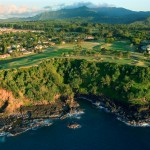
The Prince Course, photo by John and Jeannine Henebry
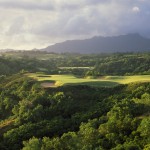
The Prince Course #7, photo by John and Jeannine Henebry
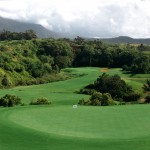
The Prince Course #13 & #14, photo by John and Jeannine Henebry
You mentioned Odysseus’s quest, but what is your own quest like?
RTJ Jr.: When I go out in search of a golf design, there aren’t any bridges or golf carts. Unknown animals are hanging around and they may or may not be dangerous. We enter their realm to create a much more refined trip for the golfer later on. The search for the best golf course within a given site is easier if the site is flat, like in Las Vegas. But then the quest involves creativity to produce something dramatic. The best courses are those where nature has provided the canvas and my job is to discover her secrets and reveal them, as opposed to imposing a philosophy. To me, bad golf architecture is what we call “production architecture” whereby the designer sets up the holes with thoughtless repetition.
If golf courses can tell a story like that of Odysseus, do they also have other stories to tell?
RTJ Jr.: Courses reveal stories in many ways. One way will bore you to death; a golfer describing a hole-by-hole account of his round will clear out a room faster than a fire.
I like to tell a story about aesthetics. Golf is a nature walk through a garden, which in every culture is an extremely important place of sanctuary and restoration and re-creation. Jesus on the cross said, “I will see you in Paradise.” The literal translation is, “I will see you in the Garden.”
But different courses tell other stories, too. I think the Princeville course—which we are currently renovating and updating for the modern era even though it hosted a World Cup and LPGA events— tells the story of romantic natural wonders mixed with championship toughness and accessibility. We’ve had several courses which stopped and were revived a couple of years later due to economic or political factors. The Moscow Country Club is the most clear example of that. In golf, when it’s seventy-two holes of medal play, or eighteen holes in a match, you’ve got to play them all, and if you get in trouble you must keep plugging along. That’s an important story. It’s a metaphor for life and golf.
Let’s come back to the Moscow Country Club in a moment. But first maybe you could go a little farther in explaining how you express your own stories or experiences through design elements in the way a writer or artist might use elements of their respective forms to express personal feelings or experiences.
RTJ Jr.: That’s when golf architecture becomes golf art, which happens at a higher level; sometimes it can be almost kitschy, but hopefully it’s evocative and harmonious. I’ve used symbolism in this way a couple of times. I built a green in the shape of the state of Texas at Las Colinas, made a brook into the Rio Grande, and shaped a bunker like Oklahoma. That was a private joke on the golf writer Dan Jenkins, who lived nearby.
I also built the Zen bunker at Princeville. I’d been working in Japan and had gone down to the temples, where I saw the sand gardens with stones in them, where people meditated. To the Japanese, those stones represent islands of time as well as the islands of Japan. To me, it looked like a bunker, so I said why not put some big stones in a hole on Kauai, which is the last major landfall off the U.S. (except for Alaska) before you reach Japan. This was in 1970, and the Japanese had not yet come to play golf in the states, but I knew they were going to. They saw the Zen bunker as a bridge, a welcome. They thought it was fun. In one sense, Zen is existential; meditation is a highly useful discipline for finding oneself. On the other hand, it can be a joke on you in the cosmic sense.
I try to design golf courses that will fascinate people so they’ll want to play them many times and learn the depths and meanings of the courses’ stories, their subtext, their poetry. There are many ways to play my golf courses. My style is very complex. You have to engage the holes, because they have character. You have all these choices, and every day there’s different ones, so the story that a hole tells depends on its mood that day, and on your mood. You should struggle with the hole in your mind. It’s not just an adversary to attack or defeat; you should talk to it, and listen to it.
Have we entered an age of golf architecture as golf art?
RTJ Jr.: I think the eighties marked the beginning of the new golden age in golf architecture, and the current era represents the environmental age. You can read our Green Proclamation on our website to hear more about that Today, we’re using less boldness, less gimmickry, and fewer natural resources in designing golf courses. When a natural element of the land affords the opportunity for drama– like the old sand quarry that became Chambers Bay, near Tacoma, Washington (and which will host the 2015 US Open)– you don’t need to trick it up. It’s always seemed strange to me, for example, to see bulkheads in the wild west.
The principal of harmony in art requires that the foreground and near ground have some shape or form and color which feels harmonious when you walk into the landscape. At the level of golf art, this has to extend beyond the golf course. It’s not just the frame; it’s everything. For example, at the Whistler Golf course, in British Columbia, Canada, in June the bunkers and the snow drifts high in the mountains relate to each other. They’re part of the same harmony, though they’re miles apart. Here in Barbados, the white-faced bunkers relate visually to the puff ball clouds that float by overhead.
How should golfers view a course architect? Are you our ally or our adversary?
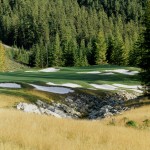
Chateau Whistler, photo by John and Jeannine Henebry
RTJ Jr.: If you read my book Golf By Design carefully, it will teach you some of my tendencies and those of other golf architects to set up a series of challenges, risks, and rewards in a golf layout, and you’ll see how and why we do that. You alone still have to play the course and make the shots, but at least you’ll have a focus. And I think people with a focus always play better. In that sense I’m your ally.
In terms of the game itself, I’m your adversary. I will set up challenges that may frustrate you if you don’t pay attention. But strategically I’m not a penal architect, like Pete Dye. I don’t say “death or glory” very often. I’ll occasionally use a penal element if it happens to be there naturally, but basically I try to give every player– men, women, children, old and young, high and low handicaps– options in playing a hole.
Being a golf architect is a bit like being a stage hand; we set the stage for the real drama. Golf architects used to just be known within the game. They weren’t known in the general sense any more than great lighting experts in the New York stage are well-known by the public.
You’ve described yourself as an environmentalist, and stressed environmentally responsible course design. Do you feel that there are some places on the planet where a golf course just doesn’t belong?
RTJ Jr.: Absolutely. We’ve actually turned down many sites because they just wouldn’t become good golf courses, because they’d be forced upon the land. This is particularly true in the mountains of Japan, where it would look like an army of Kumatsus (bulldozers) had come through. I describe such designs as “accelerating geologic time”– like by twenty-five million years. Some developers will ignore the land, and we don’t participate in that. We might relocate a substantial quantity of earth, but we’ll do it in a way that preserves natural elements such as rock outcroppings, forests, and streams— as we did at our new Rainbow Hills golf course in South Korea.
We’re efficient. We’re light on the land. But we’re not minimalists either. So-called “minimalist” courses– where almost nothing has been moved in the landscape– often leave the golfer feeling unfulfilled, like leaving a restaurant still feeling hungry. That concept of minimalism is not architectural, and very few sites are that good that you can romantically go back to basics without bulldozers. You have to build a green that drains, or you can’t putt on it. Tees have to be oriented in the right place, fairways must support heavy mowers to cut the grass, and bunkers have to hold sand. These are technical issues. If we have to recreate an unadorned site, we will– as we did at Kensington and Windsor, in Florida; but we’ll try to leave it as if we haven’t been there. We’ll realign the terrain so that it feels natural.
When I see a piece of land which is extraordinarily beautiful and also conducive to golf, I get nervous– not that I should stay away from it, but rather that I should approach it with great care. I don’t want to ruin it. I want to study it a long time and observe its character like a man getting to know a beautiful woman– he wants to know if she’s beautiful without makeup. You want to learn the true qualities of the site before treading lightly on the land. One of the jobs I have when I see a beautiful piece of land is to tell the owner the truth: that he’ll have to invest a certain amount of money just to protect the beauty, and if he doesn’t want to do it, or thinks he can do it for less, I’ll say let someone else do it.
In my opinion there are some great pieces of land which didn’t turn out as well as they might have. Tralee, in Ireland, for example, a wonderful place where Ryan’s Daughter was filmed. It was designed by Arnold Palmer and Ed Seay. Architecturally, I could see many ways to have made a better golf course. I’m a constructive critic as well as a creator. I don’t know what happened there. Maybe they didn’t have enough of a budget, or enough time. But they didn’t get the most out of that land, as they managed to do at other lovely sites, such as Spring Island, South Carolina. My father’s work at Ballybunion New was not as good as it could have been. Those are extraordinary pieces of links land. But in the case of Ballybunion I know they had almost no money, and that’s very difficult. Courses like these may be remodeled later, but they can never reach the full potential they had when the site was virgin.
As an environmentalist, is it also difficult to watch the amount of development that often springs up around a golf course built in a previously pristine place?
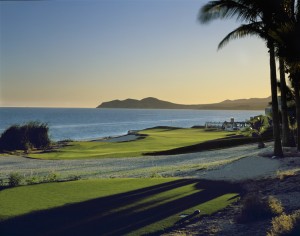
Cabo Real, photo by John and Jeannine Henebry
RTJ Jr.: This has happened many times before. In Hilton Head, South Carolina, for example, at first people thought those golf courses were just wandering through a woodland. They were, initially, but then the houses went up and the golf courses were strung out among them, much like a suburban street. At Cabo Real, in Mexico, we purposely put the golf holes along the edges of cliffs, which is dramatic and heroic, but it also means that they can’t build anything there.
Over-development is always a disappointment, but we have to work in the practical world. The best thing of all is pure golf– when you can design a golf course where there are no houses, like we did at Chambers Bay, at the Lake Course in Kunming, China, and with the first 18 holes at Joondalup in Australia. If you have enough golfers in a major urban area, the market will recognize pure golf and respond. This also happened at Granite Bay, near Sacramento. But you can’t do it everywhere. The market isn’t that rich.
Let’s go back and talk about the Moscow Country Club. It took twenty years to build that golf course. What was the process like for you? What did it mean?
RTJ Jr.: When I first saw the Reds on the greens, I knew the cold war was finally over. In the early days of the project, the golf course had a symbolic meaning in the West that the Russians were open enough to consider this. But it took them a long time to decide whether a golf course was a political symbol. They first thought of golf as an English game, and they didn’t like the English because they held Murmansk during the Bolshevik Revolution. Golf had meanings of colonial empire. I had to explain that golf was really an old Scottish game.
On a very crude level they also pointed out that golf is a capitalist game, but we pointed out that it’s not; it’s a military game. Scottish soldiers played golf in India, Egypt, and elsewhere. But British soldiers were not some of their favorite historical figures. That was even more serious. But toward the end, they didn’t see it as anything more than a way to provide a luxury service, and to encourage business and tourism.
In terms of the transformation of the people involved, it was a kind of reverse Doctor Zhivago. The Doctor was transformed by his experiences in the Bolshevik Revolution. In the case of the golf course, because it took so long, many of the Russians involved were transformed backwards to a less ideological society. Dr. Armand Hammer was the catalyst, back in 1974.
What was your toughest challenge in getting the course built?
RTJ Jr.: They never gave us an accurate map. I’m a former boy scout, and I was walking around in the woods with a compass, and I said, “This topographical map is really off.” I kept saying this and it was five years before they really trusted me. They said I was very observant.
“Is it wrong?” I asked.
“Yes. The map is incorrect.”
I asked how I was supposed to do my job and they said, “We do not give correct maps to foreigners because your military will use it to attack us.”
And I said, “Well, I’ll give you an incorrect golf course unless you give me a correct map.” Paranoia was a science over there. But for good reason. The bunkers on the third hole in Moscow are actual bunkers from which they fought the Germans in WW II. Also, I was told that the woods 30 Km northwest of Moscow were approximately where Napoleon’s army fought. They’ve been attacked so many times. They had reason to give me an inaccurate map. They finally gave me a map that was so accurate they had calibrated the circumference of every single tree in the forest.
Beyond the game of golf, what did building the course mean to you personally?
RTJ Jr.: I believe that if we can play a sport together then we might not kill each other. It’s the Olympic ideal (and just one reason why golf would make such a great Olympic sport): get guys communicating by having a competition through sports. And what sport do older diplomats and generals play? Golf.
In November 1979, I asked a major player, Ambassador V. Kuznetzov, how things were in Moscow. He said, “Things in Moscow are much colder than the snow in your face.” A month later they attacked Afghanistan. That was the end of sports exchanges, and the project went into deep hibernation.
Six years later the Russian client called up again and said Gorbachev is in power now and he wants to talk about that golf course. Then there were little things, like his government collapsing during construction. The most positive thing I can say is that at the opening, soldiers from the Red Army came to see the course and they had to try it. If you don’t build it, they’ll never see it, and never try to play.
It sounds like you have very strong feelings for the Moscow course. Do you have other favorites, courses that mean particular things to you, or express specific moods?
RTJ Jr.: When I want to play serious golf I go to Pine Valley, because I grew up in New Jersey and have been playing Pine Valley since I was sixteen, and I have a lot of memories. I go with friends and we play all day long and try to eat as many meals as rounds we play. It’s a very difficult course– walking golf. It’s like going to church: you get reinvested with the lore and the nature of the game.
To me St. Andrews is an interesting place, but I always feel slightly uneasy because there are so many oddball bounces. You have to learn to laugh with the golf course, because it’s certainly laughing at you.
I like the San Francisco Golf Club. I like Winged Foot because you have to hit really precise approach shots. It brings back all kinds of memories, too. That’s where Tommy Armour taught me how to play. It’s very evocative.
Golf Courses are like outdoor churches. They’re places you have a lot of memories of great matches won and lost, friends enjoyed, weather– all kinds of things come flooding back.
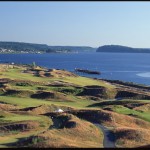
Chambers Bay, photo by John and Jeannine Henebry
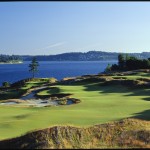
Chambers Bay #2, photo by John and Jeannine Henebry
You communicate your love for the game and some of your memories and experiences in your book, Golf By Design. Would you like to say a few words about the book?
RTJ Jr.: I authored the book for two reasons. First, I would play golf with someone at the San Francisco Golf Club who’d been playing there all his life, and I’d say “Do you usually come up short on the fifth hole?” He’d say, “How did you know?” And I’d say, “Because you see where the bunker is set fifteen yards short, but it’s a high faced bunker, the top of which obscures the fairway, and it looks like it’s right in front of the green? Your eye is tricked. There’s an illusion because there’s no background and no reference point. It’s pure ocular science. You think the green is closer and you cannot make yourself hit the club you need to hit, even though you know the yardage.” After such explanations people often told me, “You should write a book!” Eventually I got hubris and thought that I should write a book.
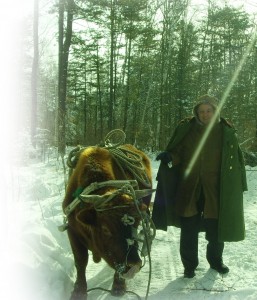
Site visit, China, 2009
But more importantly, the book was a gift back to the game, which has been so good to me. I wanted to help people understand what architects do, just as a museum curator could explain the works of Picasso and Rembrandt in a deeper way than just as beautiful paintings. I wanted to elicit a depth of appreciation and communicate the beauty, the whole ethos of being on a golf course. I also wanted to help people play better. I wanted them to defeat me.
In a Zen-like way, I’m a Master of my art, and I want to teach you my art. And if you enjoy it as I have, then I’m blessed.
